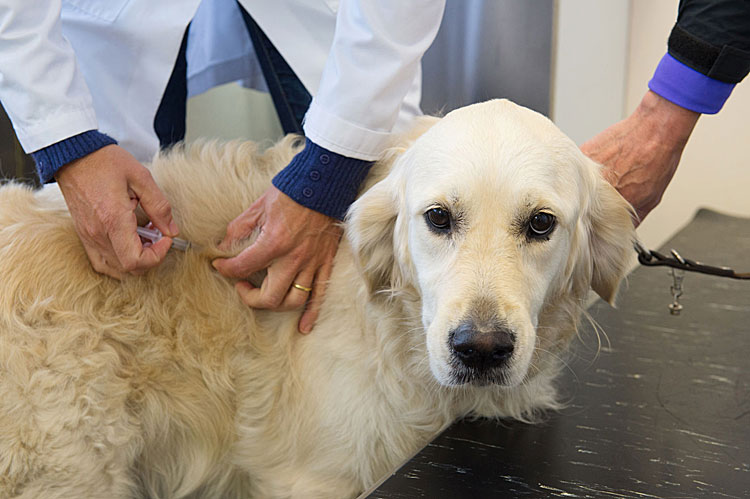By Tiffany L. Mitchener, DVM
Most Americans have never seen an animal with a case of rabies. The image of the mad, aggressive, salivating animal has been fostered by Hollywood — think “Cujo” or “Old Yeller.” Most people have a vague sense of unease regarding the disease and know the importance of maintaining their pets’ regularly scheduled “shots.” But if so few have ever personally encountered the disease, why do public health authorities take it so seriously?
What is Rabies?
Rabies is a virus that infects only mammals. It is transmitted from animal to animal when saliva from one mammal breaks the skin of another, commonly with a bite. Once a bite occurs, the virus infects the nervous system and travels slowly to the brain. There are no symptoms during this time, which can last from 4 to 12 weeks. This “silent period” is the only time that an animal or human will respond to medical treatment.
Once the virus is in the brain, it replicates and causes severe inflammation. Initially, human patients show fever, headache and generally feel sick (malaise). In a few days, neurological signs appear including tingling, itching, and numbness at the bite site, difficulty walking, trouble swallowing, and general confusion. From these signs the disease progresses to paralysis, coma and death. Most frighteningly, the disease is nearly 100% fatal in humans and animals once symptoms appear.
Does rabies exist in Santa Cruz County?
As of January 1, 2017, the California Department of Public Health declared Santa Cruz County an official “rabies area.” Our endemic rabies virus in the wildlife population is considered a public health hazard.
Bats and skunks are reservoirs of the disease in California along with occasionally coyote, foxes, and raccoons. Each year approximately 200 animals test positive for rabies in California; most are wild animals. Across the United States, 6,000 cases of rabies are confirmed in animals annually.
How do I know if a wild animal is rabid?
Because rabies virus infects the brain of an animal, unusual behaviors may develop. Any wild animal exhibiting unusual behavior should be considered rabid. It is important to watch out for:
- Wild animals that have lost their natural fear of people and appear very tame and approachable
- Any animals seen active during the day that are normally nocturnal (especially bats and skunks)
- Bats that appear unable to fly or have been caught by a dog or cat
- Any pet that is having difficulty walking, cannot eat or drink, or is showing changes in normal behavior
What if a wild animal bites my pet?
Skirmishes do occur regularly between wild and domestic animals. It is important to follow guidelines if you know your pet was bitten by a wild animal:
- Do not intervene while a fight is happening; you might be harmed. Do not attempt to capture a wild animal on your own.
- All bites should be reported to Animal Control.
- If the wild animal is captured by Animal Control, it will be euthanized and tested.
- If the wild animal cannot be caught, it is assumed rabid. If the bitten pet has proof of current rabies vaccination, it is usually recommended that the pet be revaccinated immediately and strictly isolated for 30 days (often this quarantine can be done at home). However, if the bitten dog or cat does not have proof of current rabies vaccination, Animal Control may mandate quarantine of the pet at a shelter up to six months and/or require euthanasia.
What if I am bitten?
Because of the inherent rabies potential, it is imperative that any person with wild or unknown animal contact report it quickly to a medical doctor. Wash any wound immediately with soap and water. Call a medical doctor for advice. Follow the doctor’s instructions regarding the need for anti-rabies therapy.
Why should I vaccinate my pet against rabies?
The most important line of defense in human public health against rabies is keeping pets properly vaccinated. In California, a dog must be vaccinated by a licensed veterinarian at three months, then one year, then at least every three years throughout the life of the dog. Vaccination for cats and horses is recommended but not required.
Because of our strictly enforced rabies vaccination laws, rabies disease is very rare in the United States. The Center for Disease Control (CDC) reports that there are usually 1-2 cases of human rabies in the U.S. annually. Most of these cases are associated with bat contact, but 1 in 5 come from contact with rabid dogs in foreign countries.
Incredibly, worldwide over 59,000 people die annually from rabies. Over 90% of cases are due to bites from rabid dogs. Asia and Africa are most affected; half of the victims are children.
How do I prevent rabies in my community?
- Do not handle or feed wild or unfamiliar animals.
- Avoid contact with animals when traveling abroad.
- Keep pets indoors and supervise them closely when they are outside.
- Teach children never to handle unfamiliar animals, whether wild or domestic.
- Maintain current rabies vaccinations in your pets through your veterinarian.

